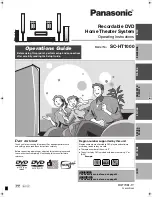
JBL Commercial CS SERIES
Application Guide
S1
= CSS‐8004
S2
= CSS‐8008
RESTAURANT
AV
Rack
Ju
ke
Bo
x
CSR-3SV
CSR-V
CSPM-2
DINING AREA
BAR
S1
S1
S1
S1
S1
S1
S1
S1
S1
S1
S1
S1
S1
S1
S1
S1
RECEPTION
S2
S2
S2
S2
S2
S2
TV
Page 6
It is possible to “clip” the amplifier signal if, for example, the receptionist were to yell
into the mic. Not only does clipping sound bad, it can damage the high‐frequency
drivers in speakers. To avoid clipping the amplifier signal, the
CSA‐2120
's built‐in limiter
is turned ON. Also, strong low‐frequency signals (such as breath pops and dropped
microphones) can cause serious damage to speakers in a 70V or 100V distributed
system by saturating the transformer. To avoid transformer saturation, the
CSA‐2120
's
built‐in 70 Hz high‐pass filter is turned ON. This high‐pass filter
must
be enabled when
using the
CST‐2120
to drive distributed speakers*. The
CSA‐2120
’s limiter and high‐pass
functionality is configured using DIP switches on the rear panel.
* Both
CSM
mixer models offer a 125 Hz high‐pass filter (which is turned ON/OFF by the rear‐panel button
labeled “XOVR”). This gives the installer two high‐pass filters in the signal chain from which to choose. To
optimize the performance of any of the four
CSS
speaker models, use
only
the 70 Hz high‐pass filter in the
CSA‐2120
. The 125 Hz high‐pass filter in the
CSM
can safely be turned OFF (the ‘Out’ position) unless “less
bass” is desired.
CSA‐2120 DIP Switch View
Summary of Contents for JBL CS Series
Page 1: ...APPLICATION GUIDE...


























